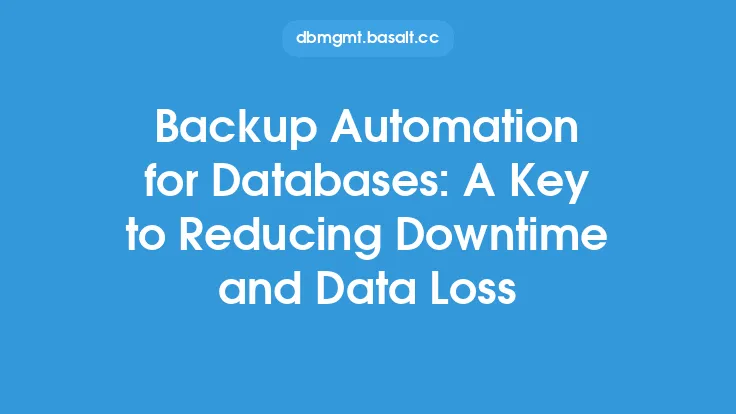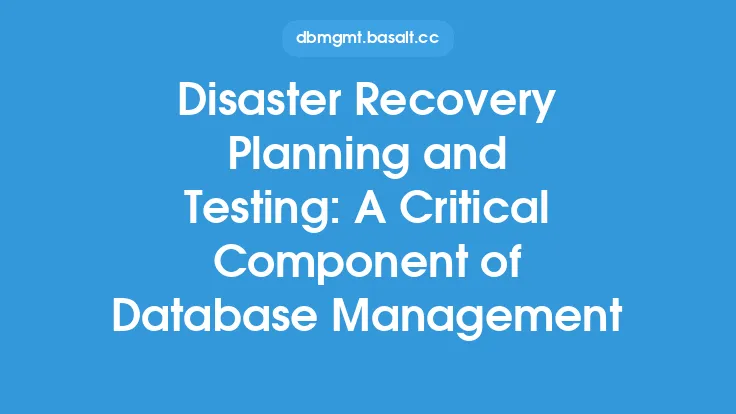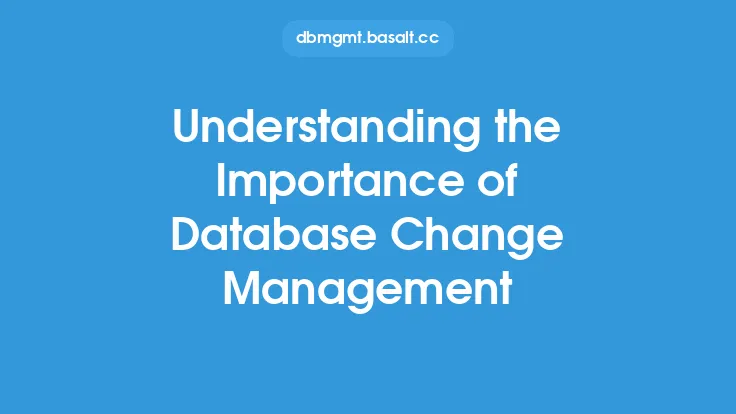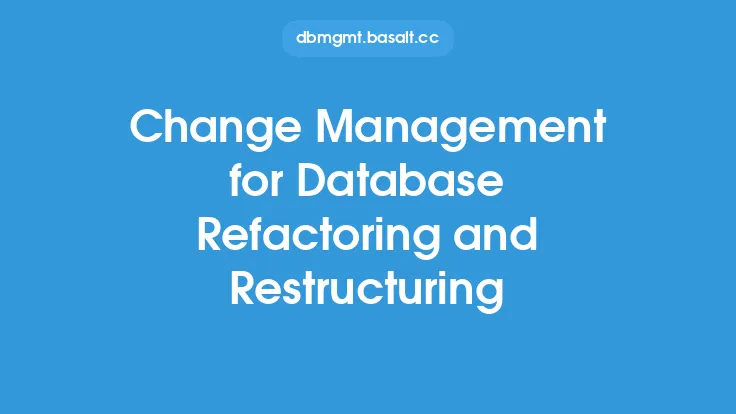Database change management is a critical process that involves planning, implementing, and monitoring changes to a database. It is essential to minimize downtime and errors, ensuring the database remains stable and performs optimally. A well-planned database change management process helps to reduce the risk of data loss, corruption, or security breaches, which can have severe consequences for an organization.
Introduction to Database Change Management
Database change management involves a series of steps that help to identify, assess, and implement changes to a database. This process includes evaluating the impact of changes, testing, and validating the changes to ensure they do not disrupt the database or affect its performance. The goal of database change management is to ensure that changes are made in a controlled and predictable manner, minimizing the risk of errors or downtime.
Key Components of Database Change Management
There are several key components of database change management, including:
- Change identification: This involves identifying the need for a change, which can be triggered by a variety of factors, such as a new application requirement, a change in business process, or a need to improve database performance.
- Impact assessment: This involves evaluating the potential impact of the change on the database, including the potential risks and benefits.
- Change planning: This involves developing a plan for implementing the change, including the steps that need to be taken, the resources required, and the timeline for implementation.
- Testing and validation: This involves testing and validating the change to ensure it does not disrupt the database or affect its performance.
- Implementation: This involves implementing the change, which can involve making changes to the database schema, updating database code, or modifying database configuration settings.
- Monitoring and review: This involves monitoring the database after the change has been implemented to ensure it is performing as expected and reviewing the change to identify any lessons learned.
Database Change Management Process
The database change management process typically involves the following steps:
- Submit a change request: A change request is submitted, which includes a description of the change, the reason for the change, and the expected outcome.
- Review and assess the change request: The change request is reviewed and assessed to determine its impact on the database and the potential risks and benefits.
- Develop a change plan: A change plan is developed, which includes the steps that need to be taken, the resources required, and the timeline for implementation.
- Test and validate the change: The change is tested and validated to ensure it does not disrupt the database or affect its performance.
- Implement the change: The change is implemented, which can involve making changes to the database schema, updating database code, or modifying database configuration settings.
- Monitor and review the change: The database is monitored after the change has been implemented to ensure it is performing as expected, and the change is reviewed to identify any lessons learned.
Benefits of Database Change Management
Database change management offers several benefits, including:
- Reduced downtime: By planning and testing changes carefully, the risk of downtime is minimized, ensuring the database remains available to users.
- Improved data integrity: Database change management helps to ensure that changes do not compromise data integrity, reducing the risk of data loss or corruption.
- Increased security: Database change management helps to ensure that changes do not introduce security vulnerabilities, reducing the risk of security breaches.
- Improved compliance: Database change management helps to ensure that changes are made in compliance with regulatory requirements, reducing the risk of non-compliance.
Challenges of Database Change Management
Despite the benefits of database change management, there are several challenges that organizations may face, including:
- Complexity: Database change management can be complex, especially in large, distributed databases.
- Limited resources: Organizations may have limited resources, including personnel, equipment, and budget, which can make it difficult to implement effective database change management processes.
- Limited visibility: Organizations may have limited visibility into database changes, which can make it difficult to track and manage changes.
- Inadequate testing: Inadequate testing can lead to changes being implemented that disrupt the database or affect its performance.
Best Practices for Database Change Management
To overcome the challenges of database change management, organizations should follow best practices, including:
- Develop a comprehensive change management process: This should include clear procedures for submitting, reviewing, and implementing changes.
- Use automation tools: Automation tools can help to streamline the change management process, reducing the risk of errors and improving efficiency.
- Test thoroughly: Thorough testing is essential to ensure that changes do not disrupt the database or affect its performance.
- Monitor and review changes: Changes should be monitored and reviewed to ensure they are performing as expected and to identify any lessons learned.
Tools and Technologies for Database Change Management
There are several tools and technologies that can help to support database change management, including:
- Version control systems: Version control systems, such as Git, can help to track changes to database code and schema.
- Change management software: Change management software, such as ServiceNow, can help to automate the change management process.
- Database management systems: Database management systems, such as Oracle and Microsoft SQL Server, offer features that support database change management, including change tracking and auditing.
- Monitoring and performance management tools: Monitoring and performance management tools, such as Nagios and Splunk, can help to monitor database performance and identify potential issues.
Conclusion
Database change management is a critical process that helps to minimize downtime and errors, ensuring the database remains stable and performs optimally. By following best practices, using automation tools, and leveraging version control systems, change management software, and database management systems, organizations can ensure that changes are made in a controlled and predictable manner, reducing the risk of errors or downtime. Effective database change management is essential for ensuring the integrity, security, and performance of the database, and for supporting business operations and decision-making.





